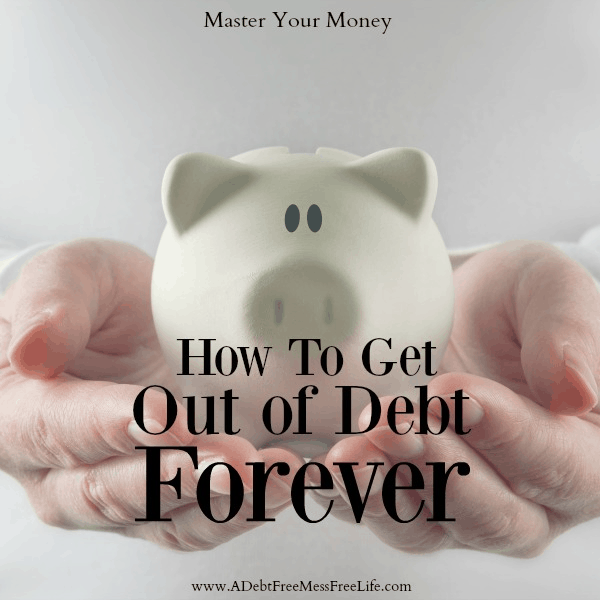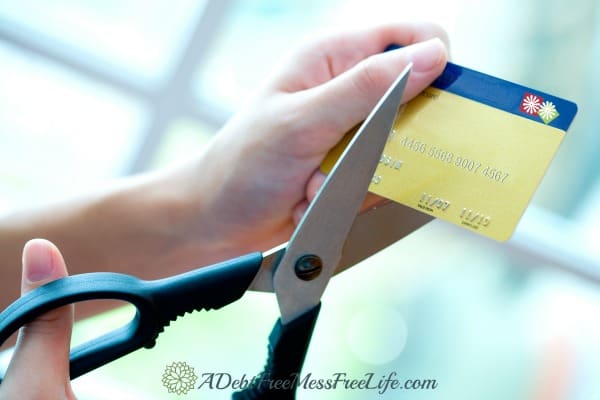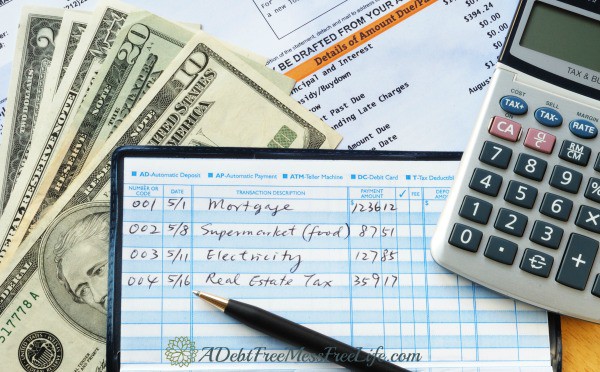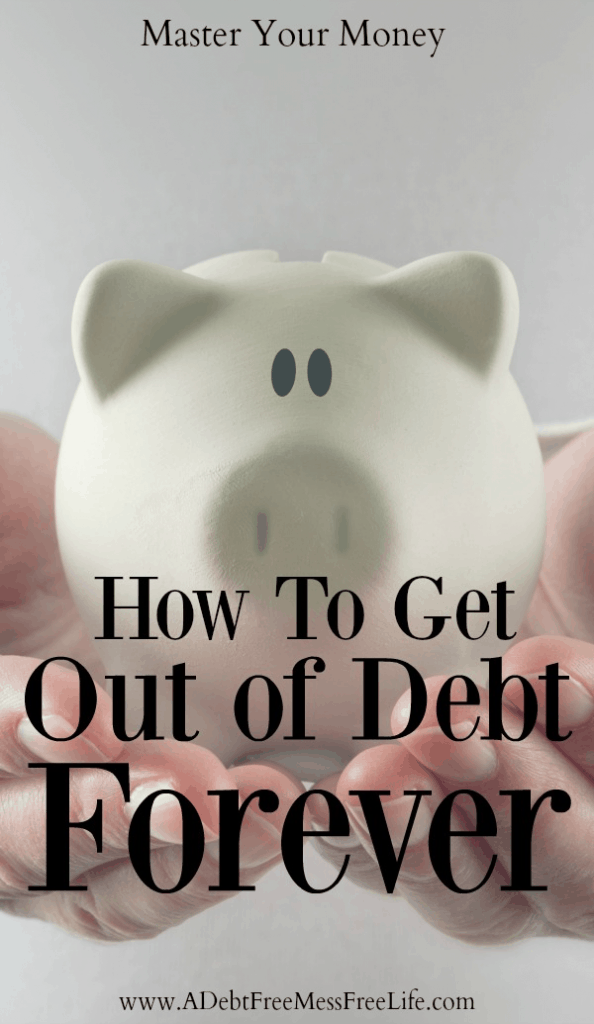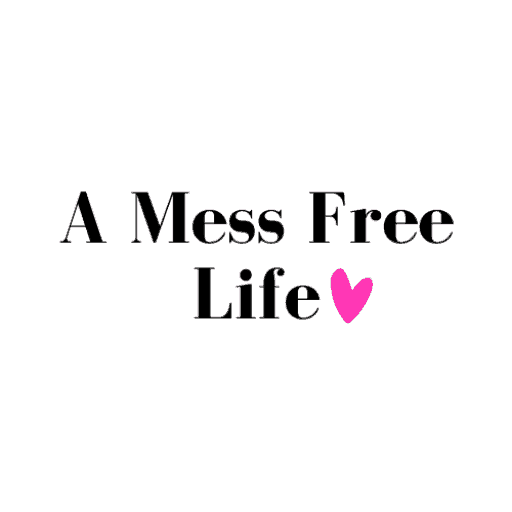A Mess Free Life may collect a share of sales or other compensation from the links on this page.
Debt is like a thief that slips into your home while you’re away and robs you of your security and self-worth. If you’ve every been in debt or are in debt right now, you know how destructive and painful it can be. So if you’re in this place right and you’re wondering what the answer is, I’m going to show you how to get out of debt and end the cycle of debt.
Table of Contents
How to Get Out of Debt and Stay There
People get out of debt all the time. In the early days of my debt recovery, I paid off a few credit cards just to turn around and charge a few more things. I finally woke up and realized what I was doing, and knew if I didn’t stop this behavior, I would never end my cycle of debt.The answer isn’t to get out of debt. It’s to get out of debt and stay out of debt – forever.
The good news is you can get out of debt, and stay out of debt. Maybe you’re familiar with the model of “Saving Your Way Out of Debt?” In this post, I’m going to share the steps you can take right now that will help end the cycle of yo-yo debting.
Step 1: Don’t Deprive Yourself
Most people start the process of getting out of debt like they do a diet. They think they have to cut out everything that is fun or pleasurable. No more going out to eat, or to the movies; it all gets slashed from their lives.
But this is a huge set up for failure – just like it is when you apply deprivation to your diet plan. In the end, you set yourself up for a relapse.
That’s what happened at the beginning of my journey. I stopped shopping, paid off a bunch of debt, adhered to a strict budget, only to have the feelings of deprivation rear its ugly head, and out I ran, credit card in hand to the nearest Macy’s.
So how do you combat this problem?
You build a spending plan that includes your essential needs so you can enjoy your life while you’re getting out of debt.
Read: Dealing with Shame and Deprivation
Step 2: Stop Using Credit Cards
The only way to permanently free yourself from the chains of debt is to stop adding to it. You have to stop using credit cards. Not using credit cards is the foundation of your financial house – a debt-free house.
You’re going to feel a lot of resistance to this step. I get it. I’ve been there.
You’re excited to pay off the debt, so you start quickly paying off your balances. But if you continue to use credit cards, this will only leave you stuck in the debt cycle for years to come.
If you are committed to getting out debt and staying out of debt, you have to stop using credit cards.
Read: Using Credit Cards
Step 3: Start Using Cash
Now that you’ve broken up with your credit cards I want to introduce you to cash. You know cash, on wait…you’ve been using credit cards for so long that you don’t remember cash. Well, it’s time to get reacquainted because it’s an important ‘how to get out of debt’ tool!
The reason you want to embrace using cash is that you’ve been disconnected from money for too long due to your credit card using ways. When you start to use cash, you start to look at your spending in a different way.
Forking over $50 for a night on the town with cash FEELS differently than when you fork over your credit card and the reality doesn’t sink in until days later when the bill arrives.
Start using cash and learn how money feels and what impact it has on you and your spending.
Read: Why Using Cash Only Is Crucial When Getting Out of Debt
Step 4: Start A Savings Account
The biggest myth floating around – you can’t start saving until you’re free of debt.
Truth be told, saving right now is the key that will free you from the never-ending debt cycle forever.
The key is moderation. Don’t go off gung-ho, depriving yourself and putting massive amounts of money on your debt. It will just blow up in your face.
Instead, open up a savings account and regularly (at a minimum of monthly) make a deposit. If you’re one of those people who have a hard time remembering to save, set up a Digit Account. Digit automatically tucks money away into a savings account for you. You don’t have to think about it. They send you updates and it’s safe, secure and convenient. Digit might be the perfect solution for you!
You’re probably wondering where you’ll get the money to put into this savings account, right?
You’ll use the excess money you were planning on putting towards your debt. For a while, you’ll just pay the minimum balance until you amass $1000 into an emergency account and a reasonable amount into a play account. If you don’t have any extra, look to reducing your expenses.
The goal here is breaking the debt cycle and create a healthy relationship with money. Using this strategy to reduce debt and build an emergency fund, will finally put you on the path towards a better financial future.
Read: 9 Easy Ways to Save $1,000 A Month
Step 5: Spend Guilt-Free
Here’s another ‘how to get out of debt’ tool that many people overlook. Now’s the time to spend the money you put into a “play” fund. The money you set aside in this “play fund” is meant to be used, guilt-free, for non-monthly expenses. You’re using this money instead of using a credit card and incurring more debt. That’s guilt-free spending at it’s best!
Step 6: Start Paying Off Debt
Once you’re no longer incurring any new debt, you’re saving monthly for emergencies and fun times, and you’ve got a solid spending plan, you’re ready to start eliminating debt.
I recommend the “snowball method” of repaying debt. Here’s how it works:
- Arrange all of your credit card debts from the lowest balance to the highest.
- Plan to pay minimum payments on all but one targeted debt.
- Designate an amount above the minimum payment you can apply to this one card.
To experience a win as soon as possible, pay the card with the lowest balance first. For example, if you have 10K on one card and $750 on another, pay the minimum on the 1oK and put any extra payments on the card with $750.
When the first card is paid off, you’re going to feel elated – and you should! Give yourself a huge pat on the back.
Now roll the entire amount you were paying on the first card, into the payment on the 10K card. You’re paying the same amount each month towards your debt, but the amount “snowballs” until you’re eventually paying the whole amount toward the biggest and last card.
Read: The Six Books I Read That Got Me Out of Debt
Step 7: Start Building Your Safety Net
Once your debt is paid off, you need to start ensuring you have the necessary long-term safety net in place to cover you if you were to ever get sick or lose your job. This type of emergency fund is money you stash away until it covers, at a minimum, 6 months of living expenses.
Personally, if you can swing it, I would shoot for a year or more of living expenses. The economic downturn in 2009 showed us it took most people far longer than 6 months to find a new job. Many people just plain gave up and in the end, lost everything.
Of course, this is a personal decision, but I encourage you to consider funding your long-term safety net for a year or more.
Conclusion:
In the end, if you implement these seven strategies you will get out of debt, stay out of debt and have a savings and safety net established to cover anything unexpected that comes your way. You will never have to wonder, ‘how to get out of debt’ because you will have finally slayed the debt dragon and found financial peace and security.
MY FAVORITE MONEY-SAVING TOOLS
EBATES: Want to earn cash back when you shop online? Ebates acts as a shopping portal offering coupons and cashback from over 2,000 online stores. I always check on Ebates first whenever I shop online! You can join Ebates for free and get a $10 welcome bonus when you sign up through this link.
DIGIT: Like the idea of saving but need something automatic? Digit is the perfect solution if trying to automate your savings strategy. In essence, what Digit does is use an algorithm to detect spare money and then transfers it to a secure savings account – so you’ll always have something to fall back on. Sign up for free!
GROCERY BUDGET MAKEOVER: Is your grocery budget giving you a serious kick in your families spending plan? Grocery Budget Makeover helped my family slash $6,000 a year from our food bill! Learn more about how Grocery Budget Makeover can help you save money too!
